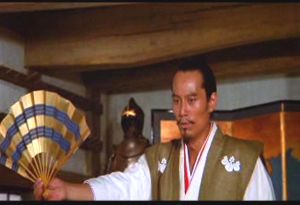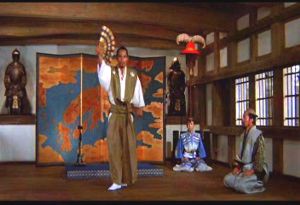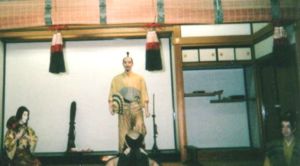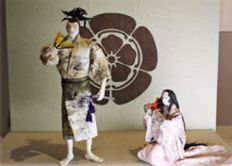A---T---S---U---M---O---R---I
S---O---N---G-----&-----D---A---N---C---E
IN KAGEMUSHA
Performed
by Ryu Daisuke
 |
 |
"
A man's life of 50 years under the sky
|
|
You simply cannot talk about the real-life Oda Nobunaga without mentioning the song and dance of Atsumori. In Kurosawa Akira's movie The Shadow Warrior (Kagemusha), Oda Nobunaga sings and dances to the hymn when finally the Takeda clan announces that Shingen is dead, verifying the Oda ninja's reports for the last 3 years; the Takedas, especially their venerated Generals like Baba Nobufusa and Yamagata Masakage -- no matter how outrageous this seems, today -- have managed to keep the patriarch's death for the entire course of three years, fooling not only the relatively 'relaxed' ninjas of the Oda clan (Nobunaga never relied on ninjas, he had a certain phobia towards the profession), but also the most zealous of Tokugawa ninjas (Tokugawa Ieyasu, on the contrary, almost 'loved' ninjas and depended heavily on them). They even successfully lied to Takeda Takemaru (a.k.a Takeda Nobukatsu, Shingen's and Oda Nobunaga's grandson), and more than that they also successfully fooled Takeda Shingen's own concubines! Tradition said that the Kai mountains (click here for pictures), native roaming-space of the inimitable warlord that Oda Nobunaga called 'the Kai long-legged monkey', were guarded so well after Takeda Shingen's remains had been smuggled home (in the movie, the remains were buried in a jar in the beautiful lake of Suwa, Takeda Katsuyori's HQ; click here for pictures); let alone a ninja, a whizz of carbondioxyde couldn't possibly get thru. That's why even after lengthy labor Tokugawa Ieyasu's ninjas couldn't make sure of the news of Takeda Shingen's death as soon as they usually could have. Oda Nobunaga didn't even bother to send ninjas, but his best General Toyotomi Hideyoshi did. Toyotomi's most famous ninja Watanabe Ken managed to sneak into the mountain recesses and verify the news, but in that venture he had to fight the fight that became famous among ninjas of 16th century, against his colleague Amakasu Sanpei (he was, actually, a Takeda, but assumed a pseudonym for the job). Watanabe killed Amakasu to keep the very precious news and relay it to Toyotomi Hideyoshi. Anyway, the audience of Oda Nobunaga's performance in the movie is one unnamed vassal (in grey formal kimono at the front) and Oda's famous valet Mori Ranmaru (in blue kimono), who would die with Oda Nobunaga at the Akechi Mitsuhide ambush, in 1582. Yet Mori Ranmaru isn't mentioned by name at all in this movie, so if you are unfamiliar with the history of Oda Nobunaga you will never know what an important figure this little youngster was in real history. The screenwriter only lets us know so via the most indirect way: at the Oda camp scene when Nobunaga offers European wine to Tokugawa Ieyasu and Ieyasu gets nearly choking by the taste, Mori laughs. No ordinary boy-valet is likely to be let to do so, therefore it must be Mori -- son of Lord Mori Yoshinari, the Judge of Gifu (this daddy is at another page; click here). In this movie Oda went to war without any of his Generals, and only accompanied by Mori. But, although Mori was Oda's constant companion at home and at war alike (and a valet's job-description did include going to war -- click here for what it means to be a valet in Oda Nobunaga's household), the absence of Oda Generals is historically unlikely because Oda was always with the best of his men like Toyotomi Hideyoshi (Oda's successor to nationwide power; Tokugawa Ieyasu only got the power after Toyotomi died a natural death), Shibata Katsuie (Oda's next brother in-law, who married Oichi after Asai's death), Niwa Nagahide, and so on. At the battle of Nagashino it is certain that the best of Oda Captains such as Okubo Tadayo , Sakuma Nobumori and Sassa Narimasa were present. Okubo, especially, was an expert of firearm combats -- which was crucial to Oda Nobunaga's victory in the battle of Nagashino. (Click here to see the real-life battle of Nagashino and who were there at the real time.) Of course Mori Ranmaru was probably the man (or the boy; he died at late teen's) closest to Oda Nobunaga all his life; and he was a good cavalier/swordsman/archer, too; yet it is unlikely that he went to combat in place of a General. At the Tokugawa side, there is a man decisive to the outcome of the battle of Nagashino who isn't even mentioned in the movie, either: Sakai Tadatsugu, a daredevil Tokugawa Captain. Sakai's brilliant tactic ensured that his boss' ally, specifically the Oda Captains, could do their job excellently. (click here for story and pictures). |
The picture above shows a life-size doll of Oda Nobunaga dancing to Atsumori, displayed at the Kiyosu castle, 2005. His long-standing servant Sai (she's been taking care of him since he was a kid) is playing the music at your left side, and Mori Ranmaru is sitting with his back to the scene at your far right. This is a re-enaction of the actual event in the morning before Oda Nobunaga went to his 'greatest gamble' in the battle of Okehazama; he only got a very small army against Lord Imagawa Yoshimoto's tens of thousands. The man with his back to you is Iwamura Nagato, one of his Captains, who was there by accident because he only wanted to ask if it was time yet to take Oda's horse out. It is an honor for a vassal to witness the dance of his Lord prior to combat. Ranmaru's father Mori Yoshinari was one of the first who got to the battlefield after Oda himself; he just finished the dance and rode away before anybody realized he had gone to war (click here for story and pictures of Oda's men). And Oda Nobunaga went to sleep soundly that same night; he had, against all odds, won the bet. For to die it wasn't his time yet.
There is another set of diorama showing Oda Nobunaga dancing to Atsumori, in the official museum of the Oda clan's stuff in Azuchi (see the picture above). Here Sai is present, but there is no other attendance. The time isn't clear either -- it might be the same Kiyosu dance prior to Okehazama, or it might also be another occassion at the Azuchi castle itself, in which case Oda was surely much older and had pocketed many victories gained at other 'impossible missions' after the Okehazama 'gambling'. CLICK HERE FOR RYU DAISUKE'S PICTURES PERFORMING 'ATSUMORI' STEP-BY-STEP |
ODA
ODA
RELATED
|
NEXT
PAGE:
ODA NOBUNAGA'S
ATSUMORI DANCE IN ANIME MOVIE


